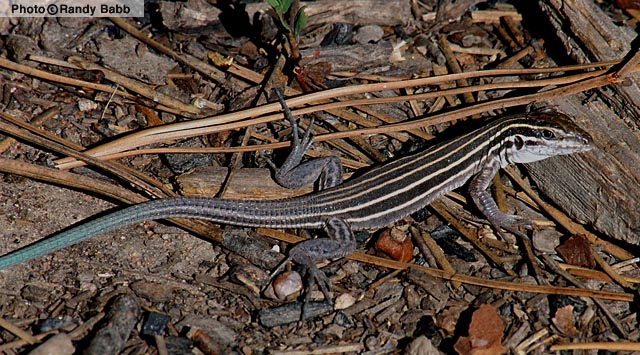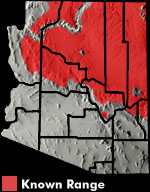Online Field Guide to The Reptiles and Amphibians of Arizona



Gila County, AZ
| PLATEAU STRIPED WHIPTAIL Aspidoscelis velox | |
|
DESCRIPTION: A small (up to 85 mm or 3.3″ from snout to vent), slim, dark brown to black lizard with a long, thin tail, and a slim, pointed snout. The body is marked with six or seven yellow to cream stripes. When present the (seventh) mid-dorsal stripe is thin and muted or discontinuous. The tail is light blue. The underside is plain and pale. Juveniles have a bright blue tail. The scales on the body are small and granular. The scales on the tail are large, keeled, and rectangular. The belly scales are large, smooth, and rectangular. The scales on top of the head are large, smooth, and plate-like. Its lack of spots distinguishes this lizard from many Arizona whiptails. Its distinctly blue tail coloration distinguishes it from the similar looking Desert Grassland Whiptail. Its lack of blue tinting on the feet and underside distinguish it from the Pai Striped Whiptail. HABITAT: A wide variety of communities are inhabited including Great Basin Desertscrub, Plains and Great Basin Grassland, Great Basin Conifer Woodland, and Petran Montane Conifer Forest. Found in an equally wide variety of terrain types including open flatlands, riparian corridors, bajadas, wooded foothills, canyons, and slopes. BEHAVIOR: This is an alert, diurnal, fast-moving ground-dweller. It is an extremely active lizard that spends nearly all of its waking hours in motion foraging and moving between sun and shade for thermoregulation. It hibernates during the cold months of fall and winter. DIET: This lizard actively forages by rooting around in organic matter under bushes and by digging in the soil around the bases of rocks, logs, and other surface debris. It has also been observed to forage in low shrubs off the ground. It feeds on a variety of insects and spiders. REPRODUCTION: All Plateau Striped Whiptails are female (parthenogenetic). Eggs are unfertilized and hatchlings are clones of the mother. Three to 5 eggs are laid in June or July. Hatchlings begin to appear in August. By Thomas C. Brennan Brennan, T. C., & A. T. Holycross. 2006. A Field Guide to Amphibians and Reptiles in Arizona. Arizona Game and Fish Department. Phoenix, AZ Degenhardt, W. G., Painter, C. W., and Price, A. H.. 1996. Amphibians and Reptiles of New Mexico. University of New Mexico Press. Albuquerque. Stebbins, R.C. 2003. A Field Guide to Western Reptiles and Amphibians, Third Edition. Houghton Mifflin Company, Boston, MA. |
|
Visit Partners in Amphibian and Reptile Conservation:


HOME
Copyright © 2023, Arizona Game and Fish Department. All rights reserved.
If you make use of the textual contents of this site in reports, publications, etc. please cite and credit the author(s) and photographer(s). All photos on this website are copyrighted. However, those found in the species account section may be used for any noncommercial scientific, educational, or conservation purposes provided that photographs are not altered and continue to bear the copyright symbol and name of the photographer. Please contact the photographer regarding commercial use of copyrighted photographs.










